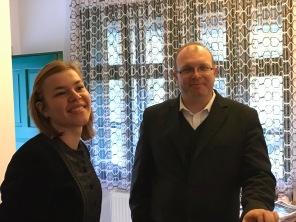Mészkö is the Hungarian word for “limestone” and on Wednesday evening three of us headed to Mészko, to the Alabaster Church for one of the five evening services held there this week. The Alabaster Church, like the town, is named for a now-dormant mine. The five evenings of services are part of the church calendar here in that sometime between
February and Easter, every church will set aside a week for a “renewal of faith” and invite a guest minister to the pulpit.

 Thisyear at this church, the minister, Robert Bálint, invited five seminary students to each give a talk. I had an interest in hearing Erzsébet Dénes speak as she is practicing English with me and I was able to hear about the theme of her sermon during a practice session. She spoke about the perspective of children, drawing on
Thisyear at this church, the minister, Robert Bálint, invited five seminary students to each give a talk. I had an interest in hearing Erzsébet Dénes speak as she is practicing English with me and I was able to hear about the theme of her sermon during a practice session. She spoke about the perspective of children, drawing on imagery from Saint-Exupéry’s The Little Prince, her experiences as an early childhood educator, and her own childhood memories. She spoke of how large, mysterious, and daunting the adult world can seem to children.
imagery from Saint-Exupéry’s The Little Prince, her experiences as an early childhood educator, and her own childhood memories. She spoke of how large, mysterious, and daunting the adult world can seem to children.
I know all this only from our conversation in English practice. What I know from being present for her service is that Erszébet is a polished and moving speaker, a beautiful young woman whose compassion and sense of calling is present in her words.
As for the church itself, it was built sometime in the late 1400s of stones repurposed from a Roman-era castle. The interior was refurbished in the 1930s, one of the several legacies of the renowned Unitarian scholar and Alabaster Church minister, Francis Balázs.
For those who like maps, daytime photos, and 360′ views, here’s what Google Maps has to offer https://goo.gl/maps/GZn55qdMeQS2.

And, for contrast, here are a few snaps of the Stony Hill Church, where I stayed last week for a few days. A new church is an uncommon undertaking, and the need to build one is not necessarily a positive signal. The need for a new church in Marosvasarhely was the result of migration from villages to urban centres, partly a natural 21st century phenomenon–but in case of Unitarians in Transylvania, a mark of the progressive success of decades of government policy to empty the landscape of Hungarian speakers.
Without financial support from Hungary, this church, started in 1999, could not have been started–and without financial support from a partner church in the US, completion would have been difficult. As it is, even though the church opened its doors in 2006, pews have only recently been added, and there remain finishing details to be done.









I am so impressed that you have settled into your work in Romania, and started the field trips out from your home base in Cluj. I think of your work as like that of the sociologist Margaret Mead in Samoa, or the anthropologist Jane Goodall in Tanzania. You have deliberately put yourself into very foreign territory and settled in to get to know the ‘locals’. Of course, things are different from home, and not as comfortable or convenient. But, you are not on a vacation, you are doing field research. As T.E. Lawrence said (at least in the movie, Lawrence of Arabia), “Of course it hurts. The trick is not MINDING that it hurts”). I love the photos, as they give me a better sense of ‘place’. I understand that you are also audio-recording interviews with Romanian Unitarians. I’ll be interested to hear some of these when you get home. Best wishes for continued success!
LikeLike
I’m glad you’re having such a good adventure, Mama. It sounds like you’ve met some neat people!
LikeLike
Moving to hear about your student. And daunting to hear about the new church. I’m just so saddened right now, thinking of our present societies’ terrible inabilities to accept difference.
LikeLike
Love that she is an Early Childhood Educator! A
little Wind Spirit Woman is with you, I think.
LikeLike
Even on still days, she lifts me up.
LikeLike